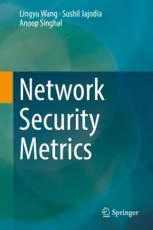Table Of ContentLingyu Wang · Sushil Jajodia
Anoop Singhal
Network
Security
Metrics
Network Security Metrics
Lingyu Wang • Sushil Jajodia (cid:129) Anoop Singhal
Network Security Metrics
123
LingyuWang SushilJajodia
ConcordiaInstituteforInformation CenterforSecureInformationSystems
SystemsEngineering GeorgeMasonUniversity
ConcordiaUniversity Fairfax,VA,USA
Montreal,QC,Canada
AnoopSinghal
ComputerSecurityDivision,NIST
Gaithersburg,MD,USA
ISBN978-3-319-66504-7 ISBN978-3-319-66505-4 (eBook)
https://doi.org/10.1007/978-3-319-66505-4
LibraryofCongressControlNumber:2017952946
©SpringerInternationalPublishingAG2017
Thisworkissubjecttocopyright.AllrightsarereservedbythePublisher,whetherthewholeorpartof
thematerialisconcerned,specificallytherightsoftranslation,reprinting,reuseofillustrations,recitation,
broadcasting,reproductiononmicrofilmsorinanyotherphysicalway,andtransmissionorinformation
storageandretrieval,electronicadaptation,computersoftware,orbysimilarordissimilarmethodology
nowknownorhereafterdeveloped.
Theuseofgeneraldescriptivenames,registerednames,trademarks,servicemarks,etc.inthispublication
doesnotimply,evenintheabsenceofaspecificstatement,thatsuchnamesareexemptfromtherelevant
protectivelawsandregulationsandthereforefreeforgeneraluse.
Thepublisher,theauthorsandtheeditorsaresafetoassumethattheadviceandinformationinthisbook
arebelievedtobetrueandaccurateatthedateofpublication.Neitherthepublishernortheauthorsor
theeditorsgiveawarranty,expressorimplied,withrespecttothematerialcontainedhereinorforany
errorsoromissionsthatmayhavebeenmade.Thepublisherremainsneutralwithregardtojurisdictional
claimsinpublishedmapsandinstitutionalaffiliations.
Printedonacid-freepaper
ThisSpringerimprintispublishedbySpringerNature
TheregisteredcompanyisSpringerInternationalPublishingAG
Theregisteredcompanyaddressis:Gewerbestrasse11,6330Cham,Switzerland
To mywife, Quan.
– Lingyu
To mywife, Kamal,with love.
– Sushil
To mywife, Radha,withlove.
– Anoop
Preface
Today’scomputernetworksare playingthe role of nervesystems in manycritical
infrastructures,governmentalandmilitaryorganizations,andenterprises.Protecting
sucha mission-criticalnetworkmeansmorethanjustpatchingknownvulnerabili-
ties and deploying firewalls and IDSs. The network’s robustness against potential
zero day attacks exploiting unknown vulnerabilities is equally important. Many
recenthigh-profileincidents,suchastheworldwideWannaCryransomwareattack
inMay2017,theattackonUkrainianKyivoblenergoPowerGridinDecember2015,
and the earlier Stuxnet infiltration of Iran’s Natanz nuclear facility, have clearly
demonstratedthe realworld significance of evaluatingand improvingthe security
ofnetworksagainstbothpreviouslyknownattacksandunknown“zeroday”attacks.
Oneofthemostpertinentissuesinsecuringmission-criticalcomputingnetworks
againstsecurityattacksisthelackofeffectivesecuritymetrics.Since“youcannot
improve what you cannot measure,” a network security metric is essential to
evaluatingtherelativeeffectivenessofpotentialnetworksecuritysolutions.Tothat
end,therehavebeenplentyofrecentworksondifferentaspectsofnetworksecurity
metricsandtheirapplications.Forexample,asmostexistingsolutionsandstandards
on security metrics, such as CVSS and attack surface, typically focus on known
vulnerabilitiesinindividualsoftwareproductsorsystems,manyrecentworksfocus
oncombiningindividualmetricscoresintoanoverallmeasureofnetworksecurity.
Also,someeffortsarededicatedtodevelopnetworksecuritymetricsespeciallyfor
dealingwith zero day attacks, which implylittle or no priorknowledgeis present
about the exploited vulnerabilities, and thus most existing approaches to security
metricswillnolongerbeeffective.Finally,somerecentworksapplysecuritymetric
conceptsto specific securityapplications,suchas applyingand visualizinga suite
of network security metrics at the enterprise level, and measuring the operational
effectiveness of a cybersecurity operations center. This book examines in detail
thoseandotherrecentworksonnetworksecuritymetrics.
There currently exists little effort on a systematic compilation of recent pro-
gresses in network security metrics research. This book will fill the gaps by
providingabigpictureaboutthetopictonetworksecuritypractitionersandsecurity
researchers alike. Security researchers who work on network security or security
vii
viii Preface
analytics-relatedareasseekingnewresearchtopics,aswellassecuritypractitioners
includingnetworkadministratorsandsecurityarchitectswhoarelookingforstate-
of-the-art approaches to hardening their networks, will find this book useful as a
reference.Advanced-levelstudentsstudyingcomputerscienceandengineeringwill
alsofindthisbookusefulasasecondarytext.
More specifically, this book examines recent works on different aspects of
network security metrics and their application to enterprise networks. First, the
book starts by examining the limitations of existing solutions and standards on
securitymetrics,suchasCVSSandattacksurface,whichtypicallyfocusonknown
vulnerabilitiesinindividualsoftwareproductsorsystems.Chapters“Measuringthe
Overall Network Security by Combining CVSS Scores Based on Attack Graphs
and Bayesian Networks”, “Refining CVSS-Based Network Security Metrics by
Examiningthe Base Scores” and “Security Risk Analysis of Enterprise Networks
UsingProbabilisticAttackGraphs”thendescribedifferentapproachestoaggregat-
ingindividualmetricvaluesobtainedfromCVSSscoresintoanoverallmeasureof
networksecurityusingattackgraphs.Second,sinceCVSSscoresareonlyavailable
for previouslyknownvulnerabilities, the threatof unknownattacks exploitingthe
so-calledzerodayvulnerabilitiesisnotcoveredbyCVSSscores.Therefore,chap-
ters“k-ZeroDaySafety:EvaluatingtheResilienceofNetworksAgainstUnknown
Attacks”,“UsingBayesianNetworkstoFuseIntrusionEvidencesandDetectZero-
Day Attack Paths” and “Evaluating the Network Diversity of Networks Against
Zero-Day Attacks” present several approaches to developing network security
metrics in order to deal with zero day attacks exploiting unknownvulnerabilities.
Finally,toaddresspracticalchallengesinapplyingnetworksecuritymetricstoreal
world organization, chapter “Metrics Suite for Network Attack Graph Analytics”
discusses several issues in defining and visualizing such metrics at the enterprise
level, and chapter “A Novel Metric for Measuring Operational Effectiveness of
a Cybersecurity Operations Center” demonstrates the need for novel metrics in
measuringtheoperationaleffectivenessofacybersecurityoperationscenter.
Montreal,QC,Canada LingyuWang
Fairfax,VA,USA SushilJajodia
Gaithersburg,MD,USA AnoopSinghal
Acknowledgements
Lingyu Wang was partially supported by Natural Sciences and Engineering
Research Council of Canada under Discovery Grant N01035. Sushil Jajodia was
partially supported by the Army Research Office grants W911NF-13-1-0421and
W911NF-15-1-0576, by the Office of Naval Research grant N00014-15-1-2007,
NationalInstitutesofStandardandTechnologygrant60NANB16D287,andbythe
NationalScienceFoundationgrantIIP-1266147.
ix
Contents
Measuringthe OverallNetworkSecurityby CombiningCVSS
ScoresBasedonAttackGraphsandBayesianNetworks.................... 1
MarcelFrigault,LingyuWang,SushilJajodia,andAnoopSinghal
1 Introduction.................................................................... 1
2 PropagatingAttackProbabilitiesAlongAttackPaths....................... 3
2.1 MotivatingExample .................................................... 3
2.2 DefiningtheMetric ..................................................... 5
2.3 HandlingCyclesinAttackGraphs..................................... 7
3 BayesianNetwork-BasedAttackGraphModel.............................. 10
3.1 RepresentingAttackGraphsUsingBNs............................... 10
3.2 ComparingtothePreviousApproach.................................. 15
4 DynamicBayesianNetwork-BasedModel .................................. 16
4.1 TheGeneralModel ..................................................... 17
4.2 Case1:InferringExploitNodeValues................................. 18
4.3 Case2:InferringTGSNodeValues.................................... 19
5 Conclusion..................................................................... 21
References......................................................................... 23
RefiningCVSS-BasedNetworkSecurityMetricsbyExaminingthe
BaseScores........................................................................ 25
PengsuCheng,LingyuWang,SushilJajodia,andAnoopSinghal
1 Introduction.................................................................... 25
2 Preliminaries................................................................... 27
2.1 AttackGraph............................................................ 27
2.2 CommonVulnerabilityScoringSystem(CVSS)...................... 28
2.3 ExistingApproachesandTheirLimitations........................... 30
3 MainApproach................................................................ 33
3.1 CombiningBaseMetrics ............................................... 33
3.2 ConsideringDifferentAspectsofScores .............................. 37
xi
xii Contents
4 AlgorithmandSimulation .................................................... 40
4.1 Algorithms .............................................................. 41
4.2 SimulationResults...................................................... 44
5 Conclusion..................................................................... 50
References......................................................................... 51
SecurityRiskAnalysisofEnterpriseNetworksUsingProbabilistic
AttackGraphs.................................................................... 53
AnoopSinghalandXinmingOu
1 Introduction.................................................................... 53
2 AttackGraphs ................................................................. 55
2.1 ToolsforGeneratingAttackGraphs ................................... 56
3 PastWorkinSecurityRiskAnalysis......................................... 57
4 CommonVulnerabilityScoringSystem(CVSS) ............................ 59
4.1 AnExample............................................................. 61
5 SecurityRiskAnalysisofEnterpriseNetworksUsingAttackGraphs ..... 62
5.1 Example1 ............................................................... 62
5.2 Example2 ............................................................... 65
5.3 Example3 ............................................................... 67
5.4 UsingMetricstoPrioritizeRiskMitigation ........................... 69
6 Challenges..................................................................... 71
7 Conclusions.................................................................... 71
References......................................................................... 72
k-ZeroDaySafety:EvaluatingtheResilienceofNetworksAgainst
UnknownAttacks................................................................ 75
Lingyu Wang, Sushil Jajodia, Anoop Singhal, Pengsu Cheng,
andStevenNoel
1 Introduction.................................................................... 75
2 MotivatingExample........................................................... 76
3 Modelingk-ZeroDaySafety ................................................. 78
4 Applyingk-ZeroDaySafety.................................................. 81
4.1 RedefiningNetworkHardening........................................ 81
4.2 InstantiatingtheModel ................................................. 83
5 CaseStudy..................................................................... 84
5.1 Diversity................................................................. 85
5.2 KnownVulnerabilityandUnnecessaryService ....................... 86
5.3 BackupofAsset......................................................... 88
5.4 Firewall.................................................................. 89
5.5 StuxnetandSCADASecurity.......................................... 90
6 Conclusion..................................................................... 92
References......................................................................... 93

